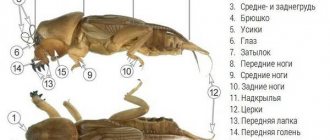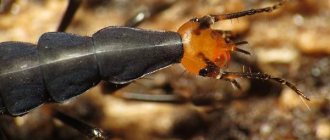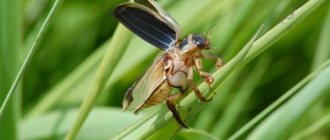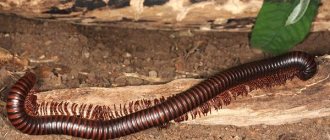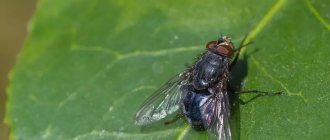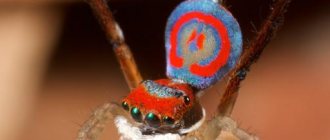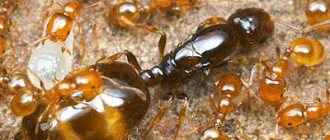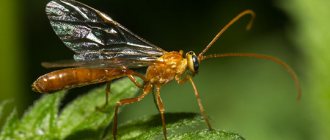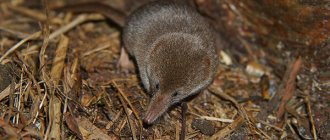What does a bear look like?
The insect belongs to the class of large invertebrate arthropods from the order of jumping neoptera. A sexually mature individual grows up to 7.5 cm and lives in burrows, which it digs itself. The front pair of limbs, which outwardly resemble ticks, helps her in this. In addition to spikes designed to loosen the earth, the legs have auditory openings. The other two limbs, the hind ones, help in movement; on the inside of them there are several sharp growths.
The insect has an abdomen, which is several times larger in size than the cephalothorax and reaches a thickness of about 1.4 cm. The upper part is covered with a hard shell, in which the head can partially hide. The mouth contains two powerful jaws designed to chew roots.
The mole cricket has several pairs of wings, the front ones being small and reaching only to the middle of the abdomen, but the other two are long and transparent with thin veins. With their help she flies.
Why is the mole cricket called that?
The insect got its name due to its brown color and dark brown small hairs covering the body, large size and sharp black claws, which are located on the front legs. It looks quite scary. Other nicknames include the following:
- Kapustyanka - this name was given to her because she loves to eat the leaves of young cabbage heads, potato tubers and beets.
- Mole cricket - for its resemblance to an insect from the same family of jumping Orthoptera, which can make sounds by rubbing its elytra, and to an animal that digs its own holes and has strong front legs.
- Earthen crayfish - for its hard chitinous shell and claw-like paws.
And also, sometimes, you can hear the nickname “top” - this is because young individuals have a gray color and pointed spines on their limbs.
Distribution and habitat
The habitat where representatives of this type of pest are found covers a very large territory: Western Europe, except for cold countries such as Norway, Asia - Central and Southeast, Transcaucasia and North African countries - Egypt, Morocco, Libya and others. In Russia, the insect is distributed everywhere - from St. Petersburg to Crimea.
The mole cricket does not like hot and dry places, so they live in the part where there is moisture, that is, near reservoirs in sandy or clay soils. The most preferable place for them is a place rich in humus, so very often the insect lives in vegetable gardens, orchards and flower beds. They love wetlands and areas with groundwater.
First, the pest settles in damp and well-manured areas of the garden, and later, if it is not destroyed, it will spread to other areas.
Traps
If a small number of mole crickets are found in the garden, then it is worth resorting to available methods of dealing with them. You can make a trap yourself using available materials.
From plastic bottles filled with liquid bait
For example, honey or molasses, as well as stale beer, are diluted. Once a pest falls into such a trap, it must be destroyed immediately, otherwise it will be able to get out and run away.
Using potato peels
In the spring, before planting potatoes, holes are dug into the entire plot area and cut potatoes or peels are placed in them. Manure or grass is poured on top. Periodically, the traps are inspected, any cabbage weeds are taken out and destroyed.
With fresh manure
They are done in the fall; for this purpose, holes 45-50 cm deep are dug, lined with film and filled with fresh fertilizer. With the onset of cold weather outside, insects accumulate in large numbers in the trap.
With the arrival of frost, the bait is taken out and scattered around the area, while the insects freeze to death. 4 traps are required per 100 square meters of land.
Types of mole crickets
There are several different species that practically do not differ from each other: they have the same lifestyle, taste preferences and appearance. The difference can only be noticed if you examine their chromosome set. There are about 110 species in total, among the known ones are the following:
- The common one is one of the largest groups that is widespread in Europe. Damages all types of grains and agricultural crops.
- African - grows up to 3.5 cm, body color is dark yellow, closer to brown. The abdomen is light yellow. It has small thread-like antennae.
- Ten-fingered - the species is widely represented in the USA and Canada. The size is from 2 to 3.5 cm. In its natural habitat it has an enemy - the ground wasp, it penetrates the mink and paralyzes with its sting.
- The Far Eastern mole cricket is morphologically close to the common mole cricket and is distributed in China, Vietnam, Japan and the Sakhalin region.
- Single-spike - differs from other species in that the thickness of its body is narrower, and the front wings have not very pronounced transverse veins. The length of a mature individual reaches 4.5 cm.
And the steppe mole cricket, which lives in the south of Russia, Ukraine and a number of other countries, is also quite famous.
What does a mole cricket eat and what causes damage to the garden?
The insect is the most common pest of fruits and vegetables; they damage the root system and the entire underground part of plants: tubers, root necks and even just sown seeds. They also harm seedlings of ornamental and berry crops planted both in open ground and in greenhouses. Very often the pest destroys the following species:
- new potatoes;
- fodder and sugar beets;
- carrot;
- white cabbage;
- tomatoes;
- bell pepper;
- beans;
- radish;
- pumpkin;
- poppy.
Cabbage weed also harms melons and melons: watermelons and melons. He also likes to eat young shoots of sunflower, hemp and tobacco. All grain crops suffer from it: wheat, oats, barley and rye. In the southern regions, the mole cricket damages citrus fruits, peanuts and tea.
In addition to plants, it also eats the larvae of insects living underground, as well as earthworms.
Food preferences
What the mole cricket eats is of interest to gardeners, gardeners, and lovers of flora and fauna. The mole cricket insect is a predator that prefers plant foods.
The mole cricket eats the soil's contents. It feeds on roots, roots, and the green part of plants that are located directly above the soil. Finds food in the depths of the earth - small insects, larvae, earthworms. A delicacy is the pupa of other insects, caterpillars, and butterflies.
Interesting!
Its feeding characteristics make the mole cricket both a useful and harmful creature. In the forest, the insect brings great benefits - it loosens the soil, saturates it with oxygen, and destroys pests. In the garden, in the garden, they are trying to get rid of mole crickets with all their might. In garden beds, it chews through green stems, destroys the root system, and gnaws root crops. Does not allow seedlings to take root or seeds to germinate.
Lifestyle of a bear
Insects are one of the most ancient species that appeared on our planet, their remains are found everywhere and they date back millions of years. This species is very tenacious and can quickly adapt to the changing conditions of the environment where they live.
As a rule, the pest is nocturnal and does not appear on the surface during the day; it spends most of the day underground. All day long the mole cricket digs in the soil, making passages and eating everything that gets in its way. Insects make sounds even while underground, thus they give a signal to their own kind.
Their passages are located at a depth of 15-20 cm and consist of numerous holes in which they do not spend more than a few days. The network of branches dug by cabbageweed can reach great distances; they move all the time, destroying crops with their powerful jaws.
Scientists have found that their chirping is many times louder than that of grasshoppers or crickets. The human ear is able to detect these sounds from a distance of more than 500 m, but only in the evening. During the day they are practically inaudible, probably due to the fact that they are afraid of being discovered.
At night, they crawl to the surface of the earth in order to find a new area where there is food. If necessary, insects can travel long distances - they fly and swim well.
Mechanical and electrical repellers
Electrical and mechanical repellers are often used to combat mole crickets. Such devices help repel insects, and at the same time they are harmless to health and do not harm the soil and crops.
But repellers have several disadvantages. First of all, they do not destroy pests, but only force them to move to another area, which will not please the neighbors at all.
And the effect of repellers appears after 10-14 days. And during this time, the pest can destroy a significant part of the crop. Another disadvantage is that repellers must work non-stop all season. Otherwise, the insects will return to the site.
Reproduction of mole crickets
After a long winter, when the ground warms up well and the air temperature does not drop below +10 degrees, sexually mature individuals crawl to the surface en masse, looking for a mate for mating. The process itself takes place underground and, upon completion, the female begins to arrange a place where she will lay eggs. Around the roots of plants, the insect digs several tunnels, where it arranges small rounded nests, which are 8-10 cm wide. Both parents are engaged in construction, then the female lays from 300 to 500 eggs.
Next, the most crucial period begins, because in order for the offspring to be viable, they need the creation of certain conditions. The female is always close to the clutch; she not only protects the future offspring, but also maintains the necessary humidity and temperature.
The timing of the appearance of the larvae depends on how well the soil has warmed up; approximately two weeks should pass, and then gray nymphs will appear. They do not yet have wings and will remain in their burrow near their mother for about a month. After the offspring becomes independent, the female dies, and the larvae will develop for several more years until they fully mature. During this period they will shed 8-10 times.
Prevention of occurrence
A typical insect light trap used to control mole crickets
To protect the area from the appearance of unwanted guests in the form of mole crickets, a number of measures should be taken. Most of them are in the nature of general recommendations carried out when counteracting various pests.
Such measures include:
1 Planting the repellent plants described earlier on the site
2 Digging of areas along the perimeter with furrows with naphthalene or special means Medvetsid
3 Systematic inspection of all types of soil and fertilizers brought to the site (manure, humus, black soil, sand, etc.) to search for mole crickets, their eggs and larvae. Approximately a third of the cases of pest penetration into plots occur with imported soil material
4 Regular weeding and loosening of the soil. Weed removal
5 During the mole cricket’s flight (mid-to-late May), use specialized light traps that are suspended above containers (you can use a regular basin) with a water-kerosene composition. Insects, flying towards the light, stumble upon a trap and fall into a basin, where a layer of kerosene located above the water envelops their bodies, causing suffocation and death
6 Since the mole cricket lives exclusively in acidic soils, it is recommended to carry out annual deacidification of the site by adding dolomite flour or lime to the soil.
At the same time, it must be said right away that some methods of preventing the appearance of pests are not applicable to mole crickets. For example, burying metal mesh around the perimeter of the site, which is very effective against moles, will not have any effect on mole crickets.
Firstly, mole crickets are somewhat smaller than moles, and secondly, unlike moles, they can move both on the ground and in the air.
Natural enemies of mole crickets
Like any other insect, mole crickets become prey to a variety of predators:
- Birds - these can be rooks, starlings, storks, hoopoes or crows.
- Insectivores - hedgehogs, lizards, moles and shrews.
- Arachnids - the wolf spider hunts for grown larvae, it waits until one of them appears not far from its burrow, then it pounces on it and eats it.
- Predatory insects - one of the representatives of this species is the beetle, which lives in Japan and China. The female finds mole cricket burrows and lays eggs there; when larvae emerge from them, they crawl inside and eat the offspring.
- Tailless amphibians - toads perfectly exterminate these agricultural pests.
Ants and ground beetles eat the larvae and destroy the eggs laid by the adults.
Bacteria and parasites also play an important role in the destruction of cabbage mushrooms; they enter their body, which leads to the spread of infection and the death of the insect.
Fungal diseases that attack the insect during winter cold and thaw periods are also dangerous for them. Pathogenic microorganisms can cause the death of an entire population.
Where do mole crickets spend the winter?
Burrows dug in the ground or in manure help insects survive frosts. Adults dig deeper holes in the cold season than in summer. Approximately up to 1 meter, and they do them not strictly vertically, but at a certain angle.
The larvae also descend into the soil for the winter, but they go deeper to a much shorter distance, somewhere around 20-30 cm.
With the onset of spring, the mole cricket comes to the surface, but not before the soil temperature rises to 15 degrees.
Causes of the pest
To recognize the insect and prescribe effective drugs to combat it, you can look at a photo of a mole cricket in the garden. There are several reasons for insect infestations:
- diluted in manure heaps, and then transferred to the ground;
- application of fresh organic fertilizer. So it spreads from other land plots;
- oversaturation of plots with moisture or too close location of water to the surface of the earth. The liquid gradually evaporates, but the soil remains wet. This creates wonderful conditions for the life of the cabbage plant.
Signs of a mole cricket appearing in the garden
When an insect appears on a garden plot, after some time you can notice traces of its activity:
- Horizontal passages located near the surface are visible next to the plants; they become especially noticeable after watering or rain.
- Young shoots dry out and are easily pulled out of the ground, and sometimes they are severely gnawed or bitten.
- The tubers are damaged and have deep bite marks.
- There are round holes in the soil, entrances to burrows, which are surrounded by a small earthen mound.
Very often, pests themselves can be seen next to damaged plants.
How to get rid of mole crickets on the plot and in the garden?
Today, experienced gardeners have accumulated a lot of advice and descriptions of the best recipes on how to quickly deal with this insect. Among them:
- Traditional methods tested by several generations.
- All kinds of repellers and traps.
- Use of insecticides.
- Destruction using various mechanical influences.
- Carrying out agrotechnical activities.
Using several methods at once will help rid your summer cottage of harmful insects forever.
Folk remedies
The following methods showed the best results:
- Using kerosene - it is usually diluted with water and poured into holes or mixed with sand and scattered around the perimeter.
- Repelling with odors that the insect does not like - this could be garlic, lemon balm leaves, bitter herbs, rotten fish heads or iodine.
- Watering the soil with chicken manure diluted in water.
- Planting plants - marigolds or carnations are not well tolerated by mole crickets.
- Wrapping the roots with a cloth soaked in dishwashing liquid will protect the underground part of the plant from the voracious cabbage weed.
Using soap and washing powder helps a lot; you just need to add them to a bucket of water and fill the vertical passages that the pests have dug. This will cause the insect to crawl to the surface, and the clutch will die.
Baits also work well, for the manufacture of which you will need a jar or bottle dug into the ground up to the neck. Beer mixed with water is added to it.
Vegetable oil has a very detrimental effect on the mole cricket and its offspring; it is added to the water and the resulting solution is poured into the entrance to the hole.
Chemicals
An excellent means of combating this can be porridge poisoned with various drugs. Among the most effective are the following:
- Rubit - comes in the form of red granules and is wheat grains mixed with a chemical component - fipronil. The method of application is very simple, you need to spread the poison into small depressions and cover it with soil on top. If you need to treat a large area, then spread the product around the perimeter of the garden every 40 cm. The death of the pest will occur in 10-13 days.
- “Medvetox” is a unique method for getting rid of cabbage weeds. The drug retains all its properties even when exposed to high temperature or when it sharply decreases. It will also be active for three weeks even after rain. The effect does not apply to other insects and has absolutely no effect on human health.
- “Thunder” is a high-quality and effective product designed to exterminate pests. The validity period is 14 days. The active substance has a nerve-paralytic effect, which leads to the death of the pest. Soil cultivation is carried out a week before sowing, and if necessary, the procedure can be repeated after a few months.
When cultivating soil, you must always take precautions: work in specially designed protective clothing, gloves and a respirator.
Agrotechnical measures
In order to take a comprehensive approach to the extermination of mole crickets, the following recommendations must be followed:
- After harvesting, it is worth thoroughly clearing the area of debris, leaves and branches. This will help you notice the pest in time.
- Dig up the garden in the fall and spring, and to a sufficient depth, with this you can destroy nests and burrows. And mole crickets that will scatter can be lured using a dung trap.
- Before planting plants, treat seed material and roots.
It is always worth carefully examining the soil, destroying weeds in a timely manner and taking other preventive measures.
Biological agents
Among the drugs that are safe for the environment, but very effective against agricultural pests, we can highlight:
- Bitoxibacillin - it has an inhibitory effect on the digestive functions of insects, and also reduces the survival of subsequent generations.
- Lepidocide – causes the death of pests from general paralysis on the 5th day after treatment.
- Boverin is an effective remedy that helps fight insects and protects plants planted both in open ground and in greenhouses.
The biological method of protection is a good alternative to chemicals.
Mechanical destruction
To combat harmful insects, it is recommended to dig a hole about 0.5 m deep in the fall and fill it with cow manure. This will become a kind of trap for the mole cricket; attracted by the smell, it will settle in the hole. After the onset of frost, the contents of the pit must be scattered over the surface, which will lead to the death of the population. Then the soil should be dug up.
You can also periodically carry out manual sampling and then burn the pests.
Other folk methods
Let's look at how to fight with different folk remedies:
Soap solution
A pack of washing powder is poured onto a bucket of water and mixed thoroughly. Then 3 liters of solution is poured into a separate hole. Immediately put on gloves and you need to catch insects running out of the ground to the surface. This is an effective method.
Kerosene
Known for its repellent odor. Take 50-70 ml of kerosene and mix it with 1 kg of sand or 3 shovels of earth. The mixture can be placed in holes or spread among green plants.
Egg shells
This is a wonderful method to protect seedlings. The shells are dipped in fragrant sunflower oil and then crushed with a round object.
Detailed pieces of shell are buried 3 cm into the soil near the plants. The oily smell will attract an insect, it will crawl to the seedlings, eat the shells and die from the sharp edges.
Ammonia
The persistent smell of ammonia has a powerful effect on the pest. To remove mole crickets, take 10% ammonia, then dissolve 3-4 tsp in 10 liters of water. Such maintenance will not be dangerous for the plantings.
Watering is done with diluted liquid, applying no more than 500 ml to a separate bush. The repellent smell disappears within a week, so the action needs to be resumed. If the leaves turn yellow, watering should be stopped.
